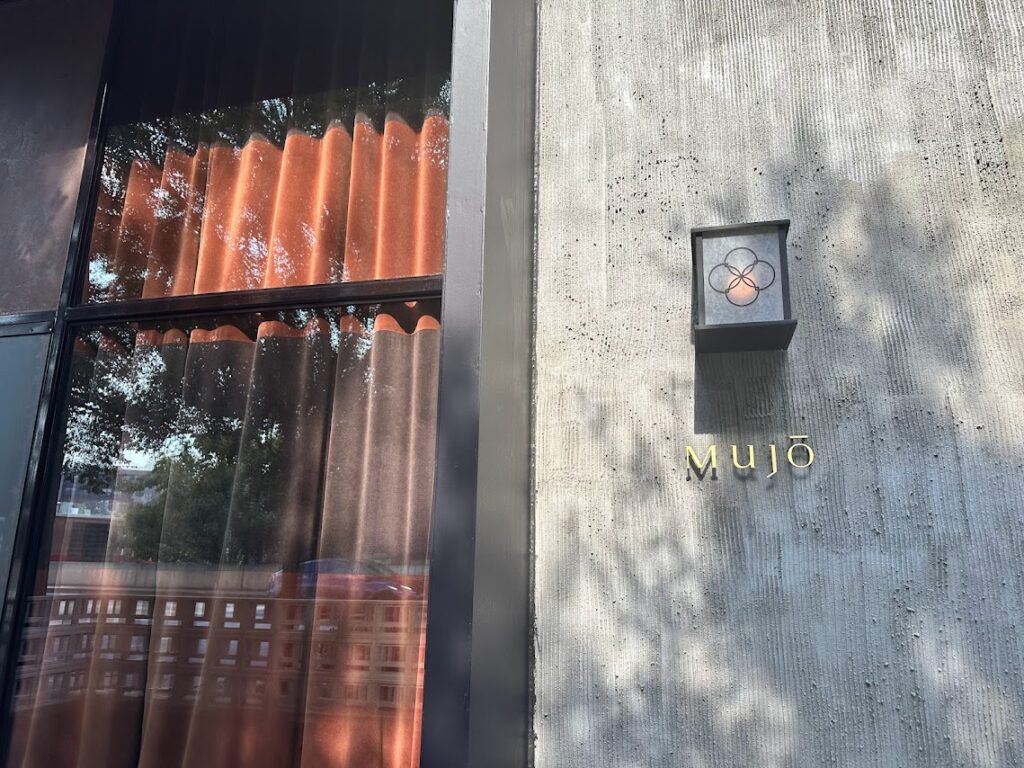This is part of a series of restaurant reviews we are doing in anticipation of Michelin coming to Atlanta. We have been to several Michelin restaurants around the world (nothing in the US yet), so we consider ourselves somewhat of a Michelin snob. Michelin publishes their official criteria of earning a star (or stars), which are the 5 tenets. Here, we will try to talk about each tenet and see how the restaurant we predicted MIGHT be Michelin worthy, fared with these 5 tenets.
Mujō is a newer restaurant that serves Omakase only. There are spaces for 14 seats and reservation can be difficult to get. The seasonal omakase costs $225 a person and the wine pairing starts at $95 a person. Please keep in mind that this is our FIRST omakase experience so we can’t compare it to anything. We had, however, done a lot of research on omakase and had some expectations and ideas about how the night should go.
The omakase experience comes with 3 Zensai (Appetizers), 10 Nigiri Sushi, and Dessert. Mujo sushi are Edomae style, a style that was developed in old days Tokyo, before refrigeration existed. Sushi chefs had to come up with creative ways to keep the fish fresh – through marinating, salting, or boiling etc. These days, we don’t have to do that any more, but upscale sushi restaurants often are Edomae style because the ingenuity and wisdom involved, and the tastier sushi that comes out as a result. Aside from the omakase, we were given a list of “supplements” to add to the meal if we want to. The supplements included options like Temaki (handroll) or Otsumami (snacks). All of the supplements come with substantial costs. We settled on the Negitoro Temaki (fatty tuna handroll) and Foie Gras Monaka.
Course 0: Coquette with Dungeness Crab
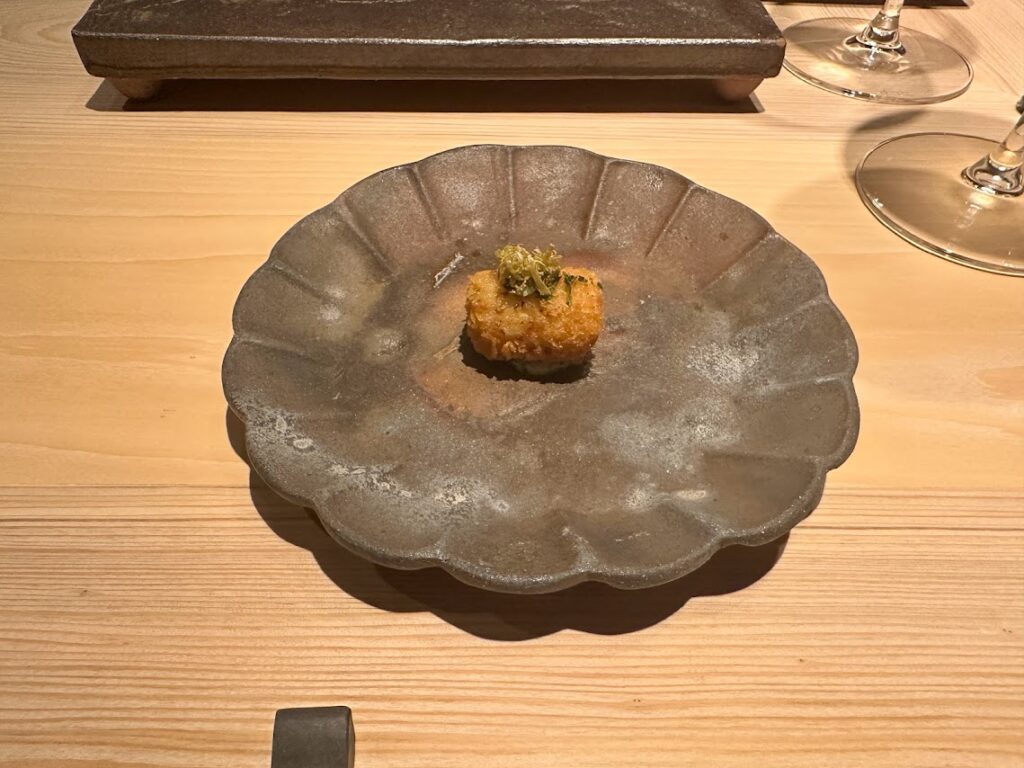
This was ABSOLUTELY amazing. The crab melted in my mouth. The outside was crispy and light. This was definitely delicious.
Zensai (Appetizers)
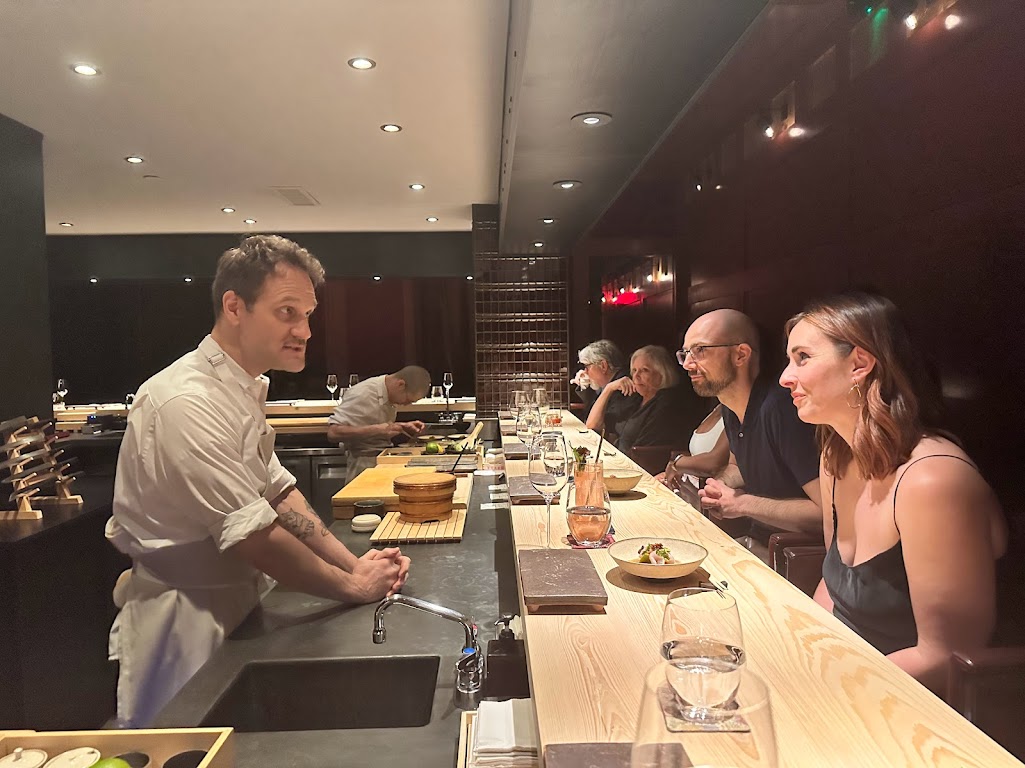
Course 1: Suzuki Sashimi
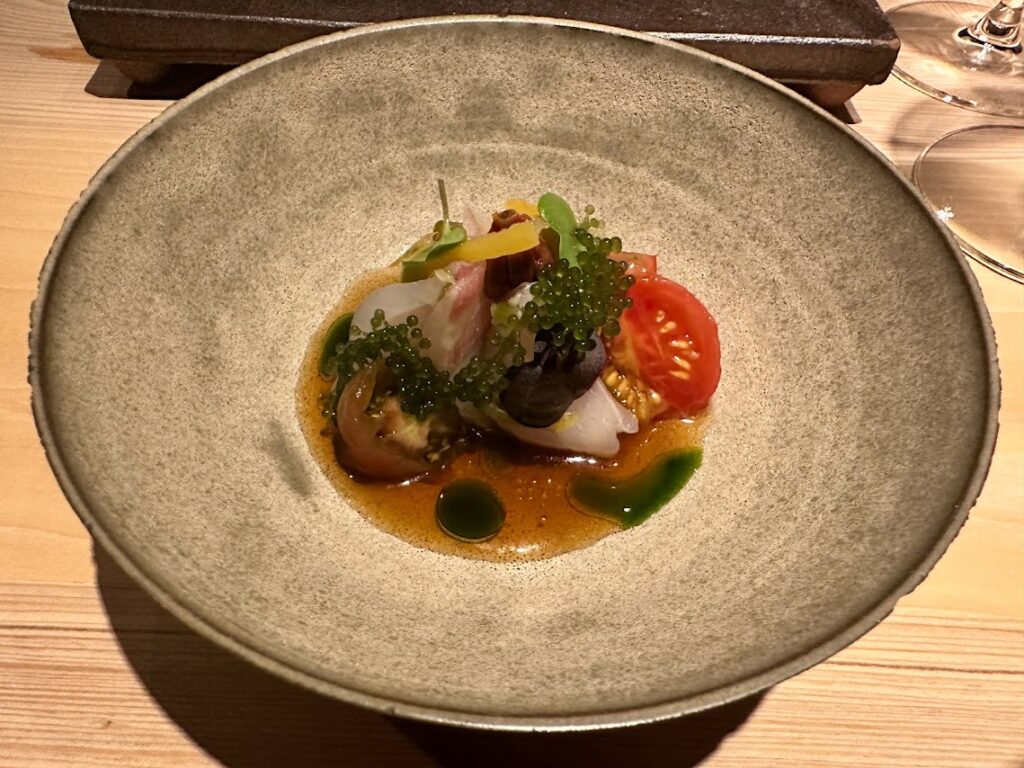
First course was a sashimi style Japanese sea bass with tomato and sanbaizu. The sea bass is decorated with a Japanese seaweed on top. This was one of my favorite dishes of the night. It was a decent amount and I loved the crunchiness of the seaweed and I thought the sauce was delicious. The tomato tasted so fresh, with great flavor.
Course 2: Cobia Misozuke
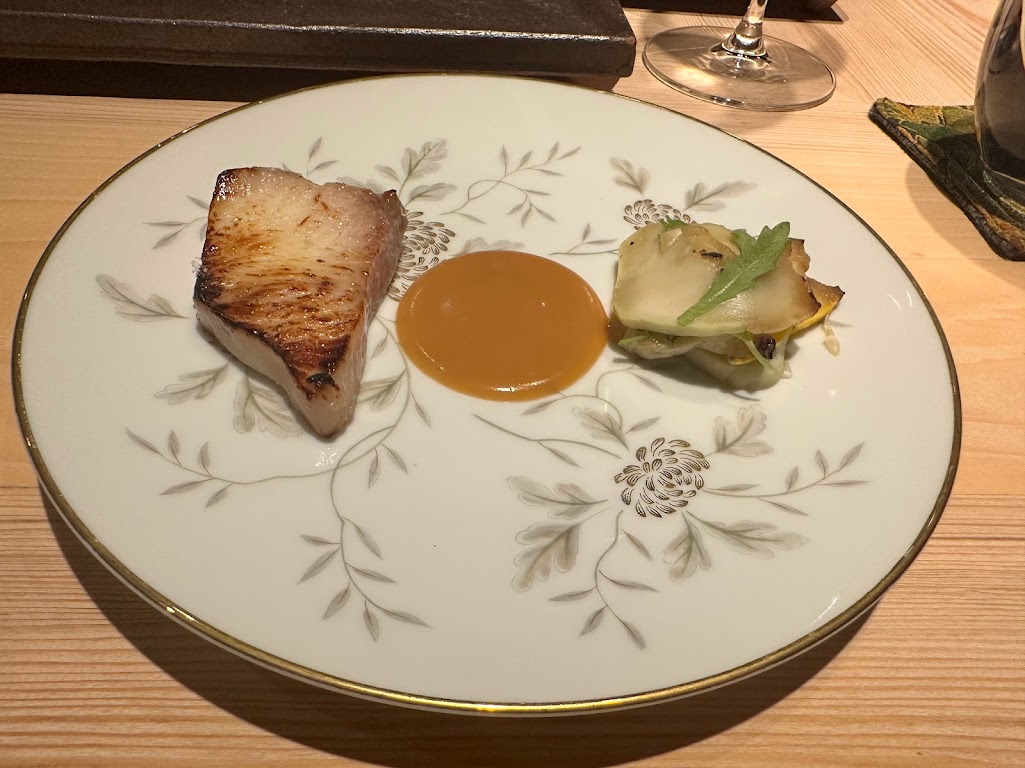
Cobia pickled in miso and served with local squashes and a miso sauce. This was good but like most miso dishes, it was rather salty.
Course 3: Chawanmushi
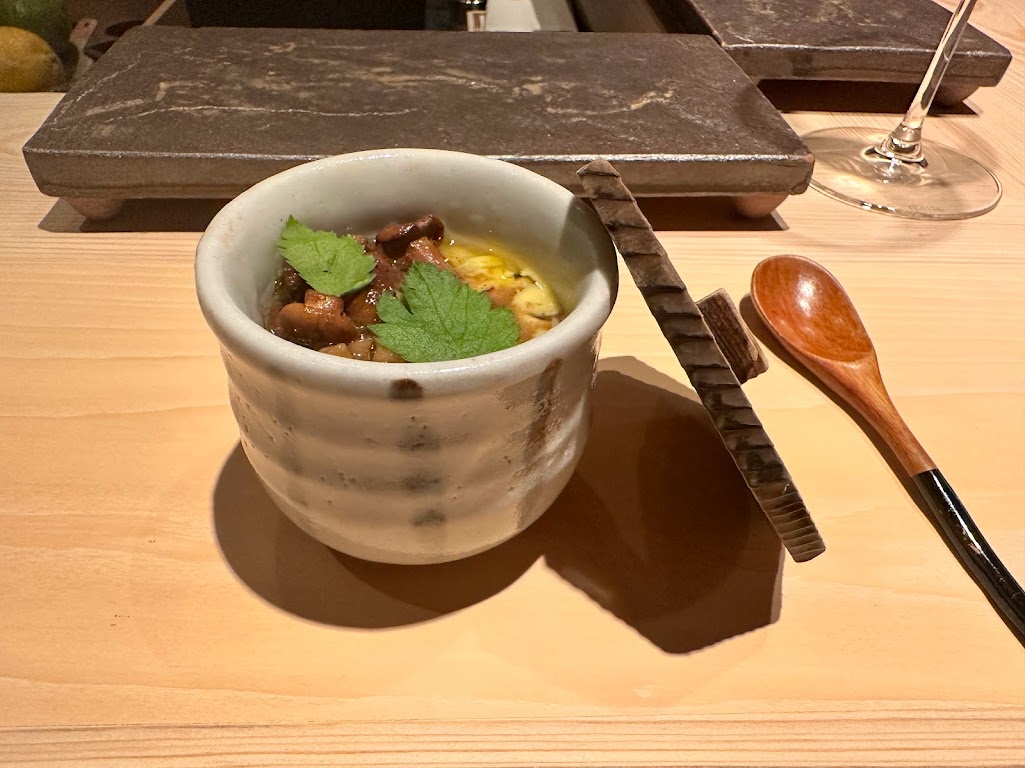
Chawanmushi is a Japanese styled egg custard. This was served with mushrooms, corn and black truffle. This was one of my favorite dishes of the night as well. I savored it SLOWLY because it was just divine.
Sushi
Now the appetizer courses are over and we are onto our sushi courses.

Course 4: Aori Ika

The first piece of sushi served was the Aori Ika, Bigfin Reef Squid. The sushi here are served from light to heavy (as it should be) so this is the lightest fish of the night. Like all squid, this had a little chew to it but it was not tough. I’m not a big fan of squid (for sushi) but I enjoyed it. I was surprised however that some people chose to have a second piece of this at the end of the night. (We were all given a chance to have an “encore” of our favorite piece, although this “chance” wasn’t complimentary by any means, so we opted out.)
Course 5: Madai
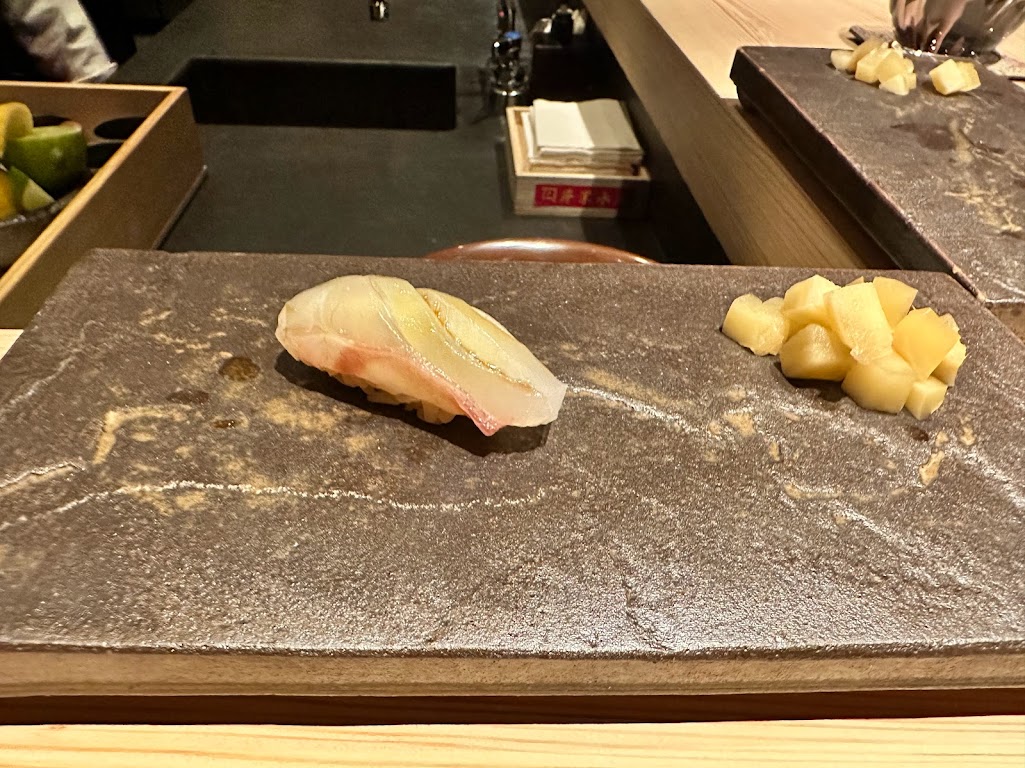
Next up is Madai, or Red Sea Bream. Delicious. No fishy taste and the wasabi was fresh and not overpowering.
Course 6: Onagadai

This course is Onagadai, or, Ruby Snapper. Fish like this are flown in daily from Japan to the restaurant. This tasted similar to me as the last fish.
Supplement: Foie Gras Monaka
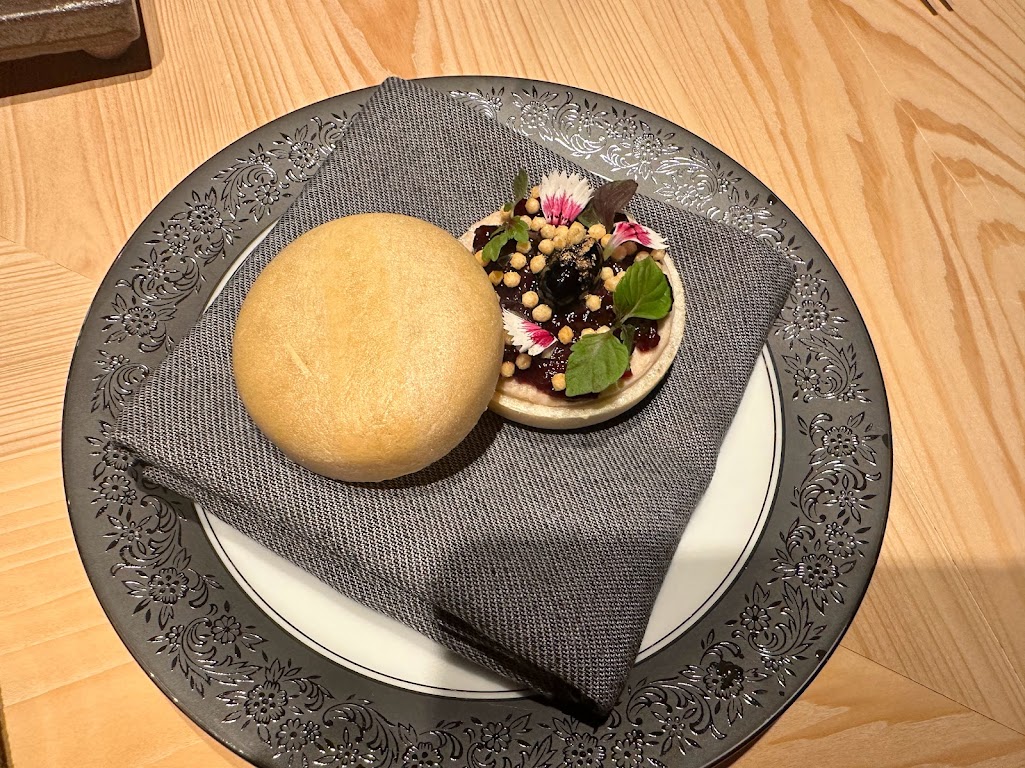
So the reason you have to order the supplements before the dinner began is so they could weave the supplementary course into your courses at the right time. The Foie Gras Monaka showed up and it was beautifully presented. We were instructed to close the Monaka and eat it like a little ice cream sandwich. There was A LOT of foie gras and it was creamy and delicious. If you like foie gras, this is a must try.
Course 7: Isaki
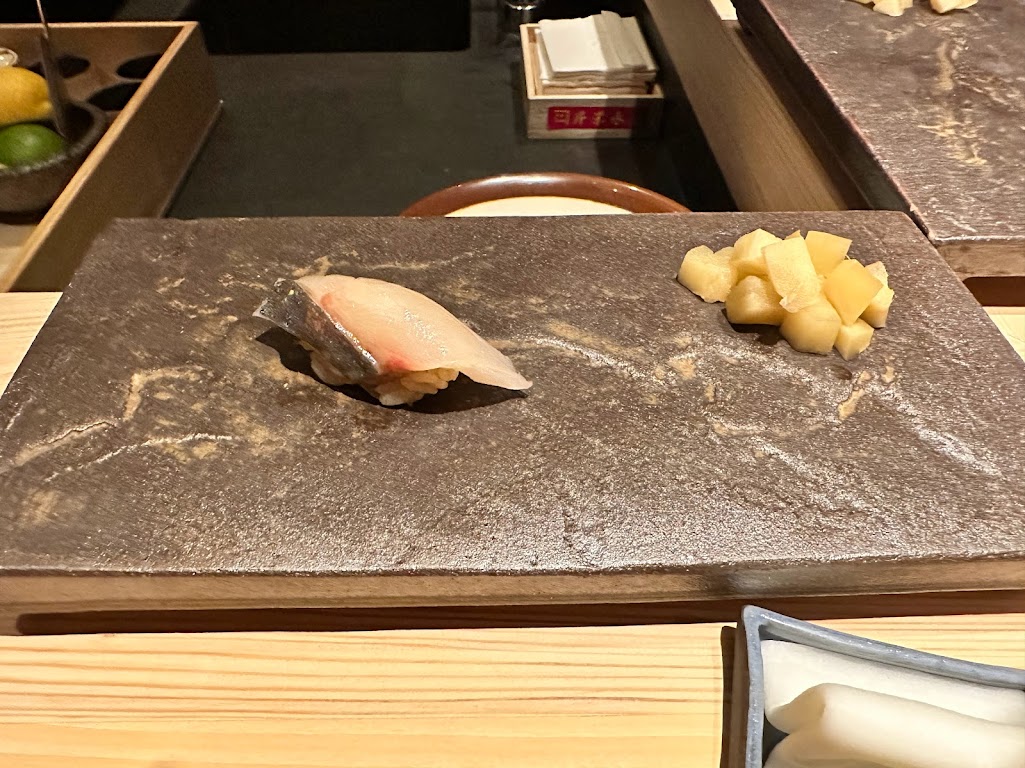
Back to our sushi courses, next we were given Isaki, which is called Threeline Grunt or Chicken Grunt in English. This is a prized fish for summertime and it was delicious.
Supplement: Negitoro Temaki
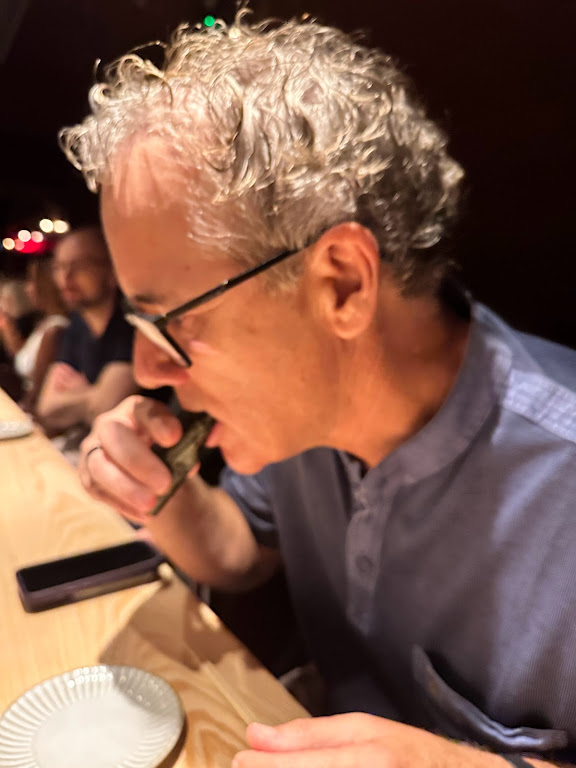
Now we were given the Negitoro Temaki, which is a handroll with fatty bluefin tuna, wasabi and green onion. I’m not a huge fan of handrolls so I did not have any. Teddy said it was good.
Miso Shiru

Now we were all given a cup of miso soup. I love miso soup and this miso soup was delicious.
Course 8: Shima Aji
Shima Aji is a juicy white fish called Striped Jack in English. I did not take a picture of this course.
Course 9: Kinmedai
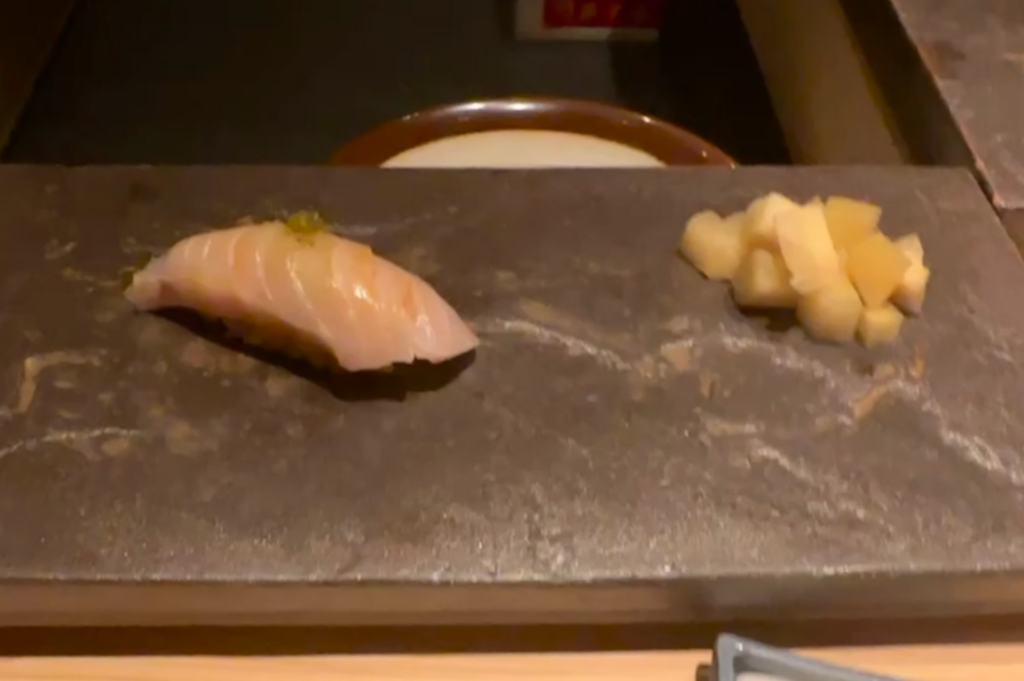
Kinmedai is the goldeneye snapper, which for Edomae sushi, is usually aged 2 to 3 days using the Ikejime technique. I honestly couldn’t tell the fish had been aged at all. It tasted good just like all of the others.
Course 10: Sawara
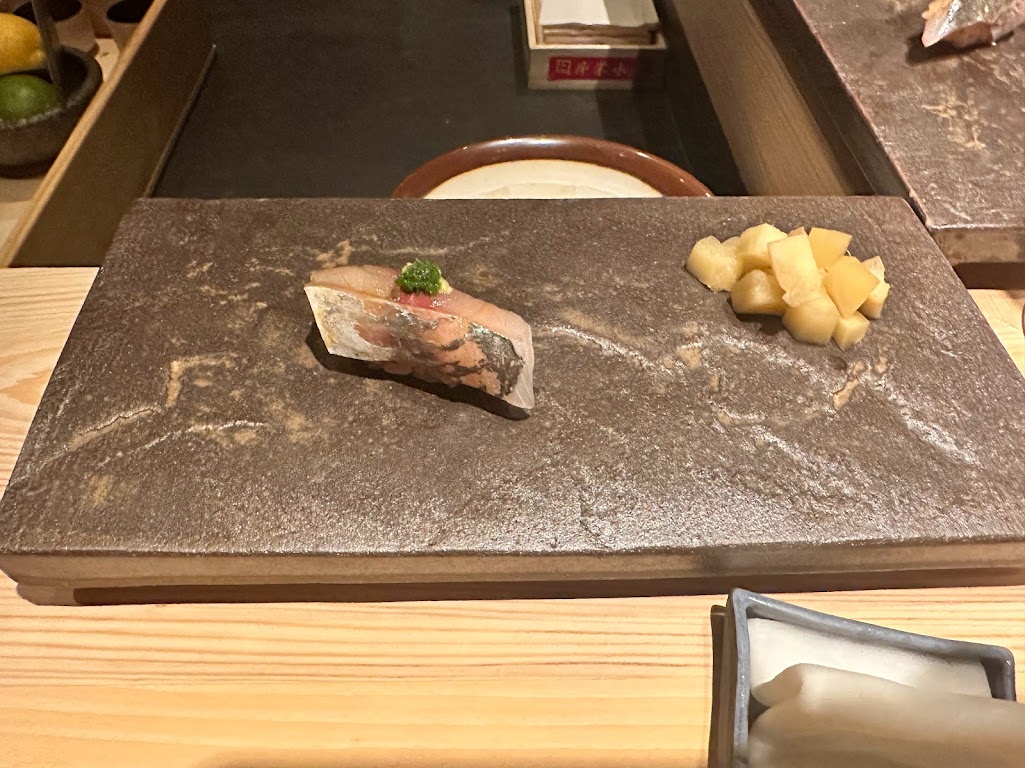
Sawara is Spanish Mackerel. Before coming here, I wasn’t a big fan of Mackerel because it was always so fishy. Not the case here.
Course 11: Aji
Aji is Horse Mackerel. It looked and tasted like Spanish Mackerel. I did not take a picture of this.
Course 12: Toro

Toro, one of the most prized sushi options. Toro is fatty tuna, which comes from the fatty part of a tuna fish. A good piece of toro shows the fat as evenly distributed veins throughout, kind of like a piece of wagyu steak. Toro was delicious.
Course 13: Uni

Uni is sea urchin, my favorite sushi always. The best uni completely melts in your mouth – like a light egg custard, but it holds its shape on top of the sushi rice. This was the best. Lucky for me, one of the guests tonight did not want her uni and offered it to me. So I got to have it twice. Interestingly, the two pieces were made by two different sushi chefs – mine made by Chef Maria Yang, hers made by the head chef, Chef Trent Harris, and the presentation wasn’t quite the same. Mine was wrapped in seaweed, hers was not. I had assumed I would enjoy the one without seaweed more – since I should be able to taste the uni more, but I was surprised that the seaweed really balanced well with the flavor of uni.
Atsuyaki Tamago
Next, we were given their version of tamagoyaki, a slice of egg bread.
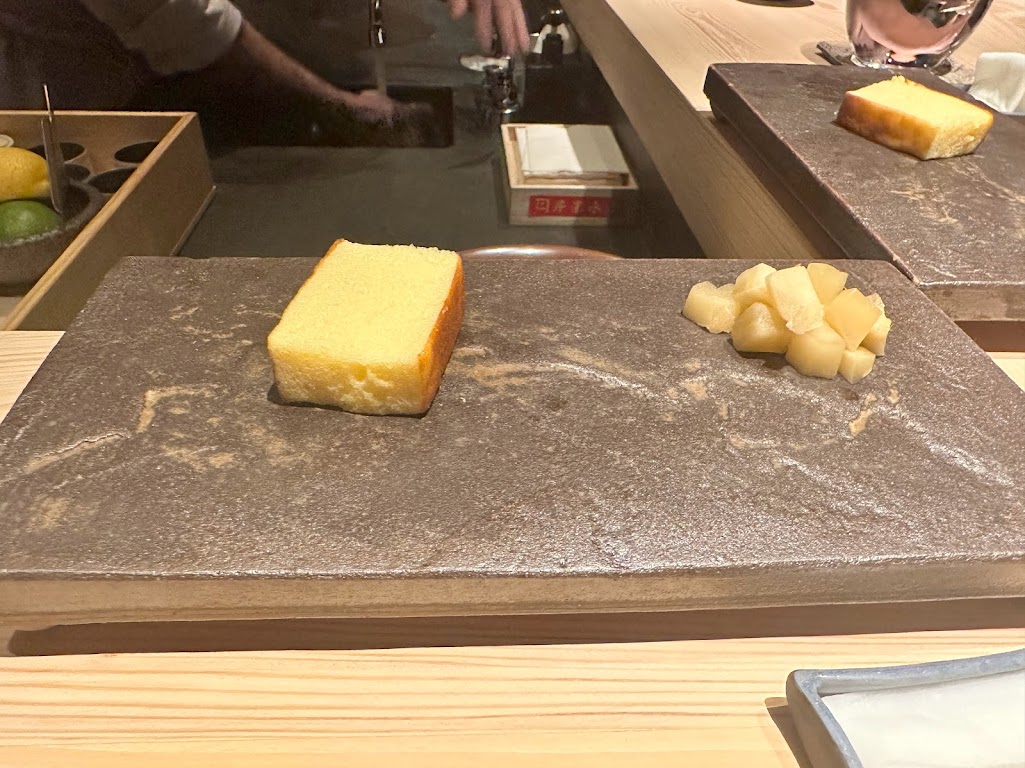
Oh this was SO good. I wanted another slice! Not that sweet, and not too much egg flavor. Fluffy and delicious.
Intermezzo

We were given some green tea and a small delicious cocktail (not pictured) as our intermezzo before desserts started.
Desserts

First course was the roasted sesame ice cream with fried Japanese sweet potato. This was one of my favorite dishes of the night, but weirdly, Teddy didn’t care for the YUMMY sweet potatoes too much.
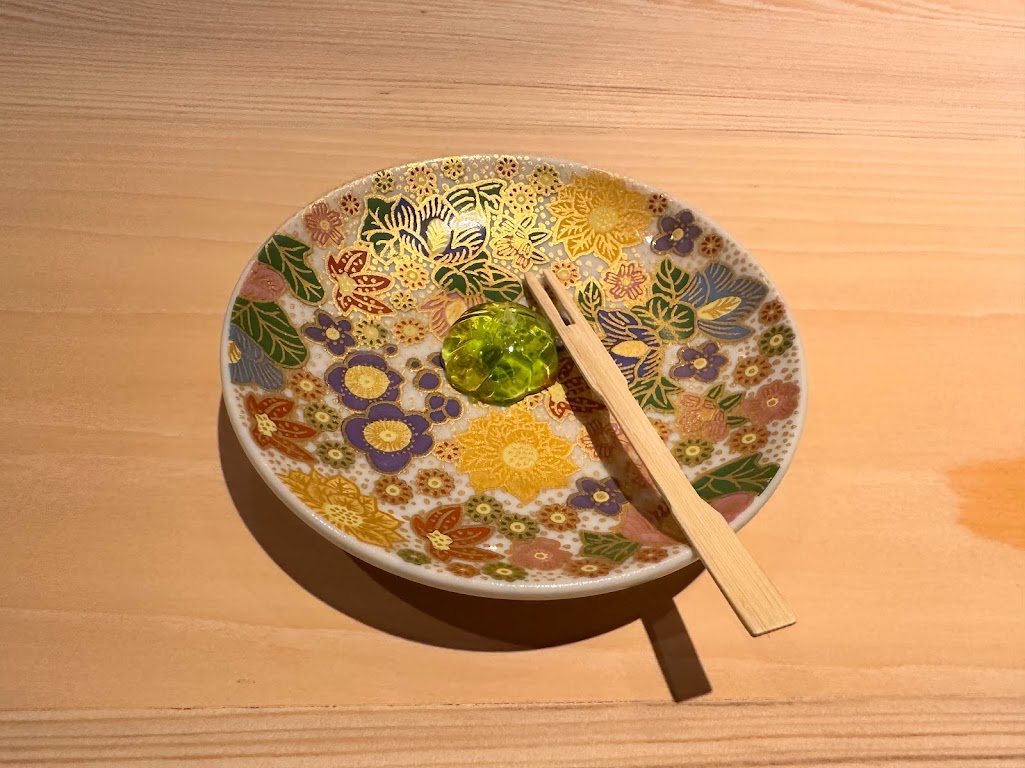
Last course of the night, a little green gummy made with Midori melon liqueur. I wasn’t sure what to expect with this but it was very good.
Michelin Star Worthy?
So how does Mujo score against the 5 tenets of Michelin Star criteria? Let’s see.
1. Using Quality Products
Mujo flies fish straight from Japan on a daily basis. For each fish, we are told which area it came from. Although we weren’t able to understand our sushi chef, Chef Maria Yang too well. Her English accent was thick. I tried so very hard to understand her initially, but I gave up later on because I realized it was interfering with the whole experience. I wish we were given the menu at the beginning so I could have at least understood what I was eating. When Chef Maria told me Spanish Mackerel, I thought she said space maker. When she said Ruby Snapper, I thought she said Ruby Slipper.
2. Mastery of Flavor and Cooking Techniques
For Edomae sushi, it takes a lot of expertise. I haven’t had Edomae sushi before and didn’t really understand the concept of it until afterwards. The executive chef J Trent Harris was professionally trained in Japan for Edomae style sushi and has previously worked at the two-star Michelin Restaurant Sushi Ginza Onodera and one star Michelin restaurant Aldea, a Portuguese restaurant that closed due to the pandemic. I think it would be safe to say that Chef Harris has perfected the flavor and cooking techniques of Edomae sushi.
3. Personality of the Chef in the Cuisine
Edomae sushi is old school sushi, which in itself is a statement of the chef himself. The courses tell a story. The fish is presented from lightest to heaviest, and the entire cuisine ends with a green dot – a little gummy infused with Midori liqueur, like a period to the end of a statement.
4. Value for Money
This was one of the most expensive meals we’ve ever had. I must say, it does feel like half of Mujo’s goal is to depart your money from your wallet (the other half is to give you the best experience they can give you). Besides the high price tag, the water comes with options of “still”, “sparkling” or “filtered”. If you choose filtered, congratulations, it’s complimentary. If you chose one of the other options, it’s $8 a person. I’ve never had omakase before, but I expected to leave feeling very satiated. I don’t think you would find that here, without adding on some supplements, all of which are priced between $25 and $75, so it adds up pretty quickly. The wine pairing isn’t cheap either – we opted for the $95 (per person) option, which is the cheaper one. The other option would have been $165. At the end of the night, the chefs ask you if you’d like to have an “encore” of any nigiri you’ve had, and if you look lost, they’ll remind you the pieces and ask you what your favorite was. It sure felt like it was part of the Omakase experience, but no, it’s an extra charge. When you receive your bill, you’ll find extra line items besides the typical tax, like liquor tax and wine tax. I guess at this price point, they feel like money must be no object so who cares? Well money definitely isn’t no object to us so I found it a bit obnoxious. (This was also the first restaurant from our list of Michelin contenders that charge for parking.) But, let’s not forget, we are paying for an experience. Clearly, the food was good, the décor was amazing, the service was impeccable, the restaurant was sparklingly clean. The restroom had seat warmers, complex bidet systems, etc. However, the atmosphere wasn’t appropriate – the music was a little too loud and the lyrics were not censored. It was weird to be listening to words like MF as I was signing the check. But let’s keep in mind that I’m not a Michelin inspector, and the one starred restaurant Hakkasan in Dubai was playing loud techno music all night.
5. Consistency of Food
Based on Chef Harris’ repertoire with Edomae sushi, I would say he’s got it down to a T by now and I think the food served would be very consistent at this point. I watched him slice the fish and each slice was made with total precision. I believe he’s also OCD – the cutting board matches the countertops and the dishes were all made of handmade clay. The ice cube has the logo of Mujo carved in it. Even the parting gift of the night – a Japanese handkerchief has the restaurant logo printed on it. You can tell the attention to detail at this place.
Conclusion
This was our first Omakase experience. It was enjoyable but I don’t think I can easily justify the cost. For comparison, I actually had sushi for lunch, and my dinner omakase sushi was definitely better than my lunch sushi, but my lunch sushi was only $16 and let me more satiated than dinner. I want to have Omakase again, but it won’t be at Mujo any time soon. It’s evident that Chef Trent Harris is a Michelin darling and there’s no doubt Mujo is on Michelin’s radar. Even though I’m not sure it lived up to the hype, I must say that a couple of people at the table told us it was the best meal they’ve ever had (and they’ve had a few Michelin restaurants before). I expect Mujo to earn one Michelin star.

